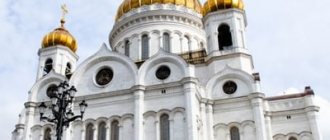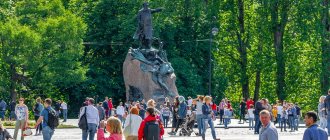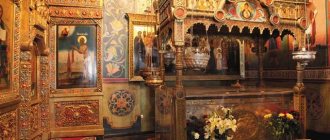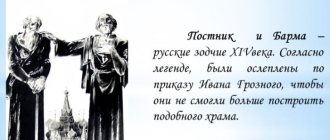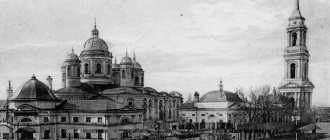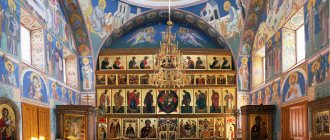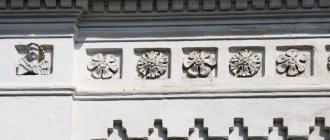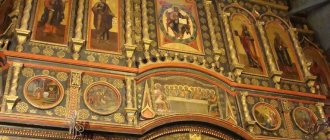| Voronezh Intercession Cathedral |
Voronezh Cathedral in honor of the Intercession of the Blessed Virgin Mary
, city cathedral of the Voronezh diocese
- Thrones: Intercession of the Most Holy Theotokos, Presentation of the Lord (right), icon of the Mother of God “The Sign” (left)
- Address: Russia, 394000, Voronezh, st. Bekhtereva, 36
- Tel. 55-53-80, 55-39-23
- Official site:
- On the map: Yandex.Map, Google map
The first mention of the Intercession Church is found in the “Watch Book” of Grigory Kireyevsky, dated 1615: “ The settlement of Belomestny atamans and Cossacks, and in the settlement there is a church in the name of the Intercession of the Blessed Virgin Mary, wood, dumplings, with a porch, and in the church there are images and bells and everything church building of the parish people
." The definition of “new” is not used in relation to it, so its appearance can be dated back to the beginning of the 17th century.
It is known that in 1700, Saint Mitrofan, the first bishop of Voronezh, gave a blessed charter for the construction of a new church, since the previous wooden church had fallen into disrepair. The original of this charter at the beginning of the 20th century was kept in the Church of the Intercession under glass in a wooden frame suspended from the middle left column of the refectory.
The wooden church stood for more than a century, and in 1736 the construction of a stone church began on this site. In 1748, the chapel was consecrated in the name of the Presentation of the Lord. At the end of the 18th century, a second chapel appeared in the temple, in the name of the icon of the Mother of God, called “The Sign,” it was consecrated on February 11, 1796 by Bishop Methodius (Smirnov) of Voronezh and Cherkassy.
In 1791, a low three-tier bell tower was built. One of its builders was stone mason Mikhail Spiridonovich Turchaninov. At the belfry, the largest of the bells, delivered from Moscow, weighed 181 poods 5 pounds (a little less than three tons).
Soon the need arose to rebuild the main temple, and on March 2, 1833, Archbishop Anthony (Smirnitsky) issued a new charter for the temple. The author of the design of the temple part could have been the provincial architect Ivan Andreevich Blitsyn (1781 - after 1841). It is known that the All Saints Church was built according to his design at that time, and its architecture has many similarities with the design of the dome of the Intercession. The main work was completed in 1835, but the finishing was delayed until 1841, and the church was consecrated on July 14, 1841 by Archbishop Anthony (Smirnitsky).
In 1839, the Little Russian Kuzma Safonov carried out “the renovation of two iconostases and all the icons of the church.” In 1847 and 1848, warm chapels were consecrated - in the name of the Presentation of the Lord and in the name of the icon of the Most Holy Theotokos, called “The Sign” - built in the refectory by the merchant S. P. Evfimov and “the diligence of the parishioners.”
Architecturally interesting is the priest's house, built next to the temple according to a “model” (standard) design at the beginning of the 19th century.
In the temple fence there was a small cemetery where the priests were buried - Grigory Grigoriev, Archpriest John Avsenev (1804-1892), who served in the temple for almost half a century, and Nikolai Egorov (1860-1904). Long-term church elders Longin Kirillovich Shashkov (1779-1858) and Vasily Onufrievich Ukhin, benefactor merchant Sergei Petrovich Evfimov (1784-1850), and merchant Tatiana Rodionovna Panina also rested here.
During the next renovation in 1872, “through the efforts of church warden V.O. Ukhina" both aisles were restored in the refectory, and the iconostases of the main church and the aisles were covered with red gold. The last time the church was consecrated after another renovation was on September 25, 1893 by Vicar Bishop Vladimir (Sokolovsky).
In 1904, the Intercession Church counted 1,282 people in its parish. The church staff consisted of two priests, one deacon, and two psalm-readers.
In the pre-revolutionary description of the cathedral, only a silver ladle, which Empress Anna Ioannovna granted to one of the Don Cossacks, was mentioned among things valuable in artistic or historical terms.
In 1921, valuables were confiscated from the Church of the Intercession to the fund of the famine-stricken Volga region (acts of confiscation were signed by priests John Putilin and Pavel Smirnsky. The church was closed and turned into a stable by the new government. In 1923, renovationists established themselves in the Church of the Intercession. The newly registered community was headed by Archpriest Vasily Izhogin.
In 1926, priests Pyotr Novoseltsev (1883 - 1937), Pavel Pashin and Pavel Smirsky (1873-1937) actively supported Archbishop Peter (Zverev) in his fight against the church schism.
In October 1927, it passed into the hands of the Gregorians: “ the autocephalists broke into the Intercession Church with impunity, broke open the royal doors in the altar, and expelled the Orthodox clergy
". In 1928, the Gregorian schism was led by Vissarion (Zornin) with the title of Archbishop of Voronezh and Zadonsk. The rector of the temple was Archpriest Alexy Popov, who previously served in the church of the Intercession Monastery. In 1930-1931 The Gregorian diocese was headed by Bishop Jerome (Baritsky), who was listed as the deputy of Metropolitan Vissarion of the Central Black Sea Region.
Divine services were held in the Church of the Intercession until May 1932, when the regional executive committee decided to seize the building from the community and transfer it to the House of Defense. Then an anti-religious museum was located in the temple.
In 1943, the building remained behind the Museum of Local Lore. It was restored according to the design of the architect Boris Nikolaevich Zotov (1896-1963).
Renaissance
In August 1945, the so-called “twenty” arose, led by Mikhail Pavlovich Vdovin and Fyodor Tikhonovich Khrenov, who began to petition for the return of the temple to believers. Twice these petitions were supported by Patriarch Alexy I with his appeals. On March 2, 1948, the Council for the Affairs of the Russian Orthodox Church decided:
«Satisfy the petition of believers to open the Church of the Intercession in the city of Voronezh and invite the commissioner of the Council under the Voronezh Regional Executive Committee to register the community and formalize the transfer of the church building and religious property to it
«.
On May 26, 1948, the building was transferred to the Orthodox community.
On October 14, 1948, on the patronal feast day, in front of a huge crowd of people, Bishop Joseph (Orekhov) of Voronezh and Lipetsk consecrated the Znamensky chapel in the refectory. The Church of the Intercession became a cathedral - the bishop's department was moved here from the St. Nicholas Church. Two purchased houses were restored in the churchyard, one of them became the residence of the bishop.
On October 7, 1951, after restoration, the cathedral was consecrated by Archbishop Joseph, concelebrated by 14 priests.
On November 23, 1952, a chapel in the church was consecrated in the name of St. Tikhon of Zadonsk.
Metropolitan Joseph (Orekhov) (1871-1961) was buried near the main altar.
Major repairs and renovation of the cathedral were carried out in 1961-1962 under Bishop Sergius (Petrov) of Voronezh and Lipetsk.
Since the late 1970s, construction of a drama theater began near the temple. The fencing of the work site came very close to the church yard. The bishop's residence and office were demolished.
On May 6, 1982, the 300th anniversary of the Voronezh diocese was solemnly celebrated in the Intercession Cathedral.
In 1982-1984, local authorities intended to demolish the cathedral; they managed to defend it thanks to Metropolitan Methodius (Nemtsov).
In 1989, the relics of St. Mitrophan of Voronezh were transferred to the cathedral.
From 2003 to 2012, a major restoration of the cathedral was carried out - communications in the temple were completely changed, the interior, carved iconostases, and icon painting were updated. Masters from Penza painted new frescoes and icons. Two small chapels in the refectory part of the temple have been updated.
On September 30, 2012, Metropolitan Sergius of Voronezh and Borisoglebsk, concelebrated by the vicar of the Voronezh diocese, Bishop Andrei of Ostrogozh, performed the great consecration of two renovated chapels of the Intercession Cathedral in the city of Voronezh - in honor of the Presentation of the Lord (southern aisle) and in honor of the Icon of the Mother of God “The Sign” (northern aisle) .
From 2014 to 2021, the bell tower was repaired and the external facades of the cathedral were restored, and in 2021 the adjacent buildings on the territory of the cathedral were restored.
On the territory of the Intercession Cathedral, a baptismal church in the name of the Holy Prophet, Baptist and Baptist John, the building of the Voronezh diocesan administration, a Sunday school, an icon painting school and Church Slavonic language courses for adults were built, and an Orthodox brotherhood was organized.
In the refectory located on the territory of the cathedral, the poor can receive a hot lunch.
Construction of the Intercession Cathedral in Voronezh
The cathedral is rectangular in plan (elongated along the “west-east” axis), with helmet-shaped domes. The main structures of the main temple volume are lowered girth arches and sail vaults supporting a large drum; the six-pillar refectory part is covered with three pairs of cross vaults. Facing the open square, the front façade is topped with a three-tiered bell tower.
The Intercession Cathedral in Voronezh is a descendant of the original Intercession Church, which could be the same age as Voronezh, founded in 1586 as a guard fortress, and in any case, built before the beginning of the Time of Troubles in Russia, when Voronezh residents, suffering from hard times, hardly cared about the construction of new temples.
The temple was built by Sloboda people on Myasnaya Gora in Belomestnaya Sloboda, which was located outside the walled “city” (i.e., the military fortress that was the heart of ancient Voronezh), but within the boundaries of the fort that protected the settlement.
Legends of Voronezh. "Harem House"
RIA Voronezh continues the special project “Legends of Voronezh”. Correspondent Maria Andreeva, with the help of local historians, finds out what legends are shrouded in the city's attractions and tries to separate the truth from the myths. On Thursday, April 21, the object of the column was a building from the former complex of the Pokrovsky nunnery, in the area of \u200b\u200bthe old Devichka (Rabochiy Gorodok Street, 30).
After the 1917 revolution, the townspeople nicknamed it the “harem house.” The logic of the Voronezh residents was ironic - in the place where the nuns live, there are many women - which means the monastery is a harem.
The ancient Pokrovsky nunnery was known far beyond the borders of Voronezh. The monastery was founded in 1623 with the blessing of the father of the first tsar of the Romanov dynasty, Metropolitan Philaret. The monastery was built on a hillside, next to the Voronezh fortress. When the construction of shipyards began in Voronezh, the nunnery moved to the distance - to the Ternovaya Polyana tract.
Since the 1770s, new novices were accepted into the monastery only if they contributed significant funds for the construction of a cell and food. The monastery was special: each nun or novice had her own cell - a separate house. As a result, the real estate of the Intercession Monastery became huge - in 1912 there were 257 separate buildings there.
By the beginning of the twentieth century, the Intercession Convent had become a real town: more than a thousand residents, two churches, a hospice house, a hospital and many cells. The monastery occupied the territory almost from the current Sacco and Vanzetti streets to the Voronezh River.
Monastery at the beginning of the twentieth century
But during the revolutionary years, all this rich property was taken away and the cells were given to the working people. The territory of the monastery was given a name - Rabochy Gorodok Street, and the neighboring streets were named Proletarskaya and Democracy. A club was turned into one of the churches, and an apartment building was turned into an apartment building from the Church of All Saints of Pechersk.
Ruins of a church in the 1980s
During the Soviet years, a new part was added to this building - a brick two-story rectangle. The building of the 1830s still has semi-oval windows, stucco molding, and columns - clear traces of the temple.
There are many things that remind us of the Intercession Monastery in Rabochiy Gorodok. In the courtyard there is a semicircle of the altar apse - the holiest part of the temple. They broke through the door and windows, and built a storage room for shovels and other household utensils.
At first, the local residents argued with me - they did not believe that there was a church in the building. Many believed that this was the house of Mother Superior. And once I heard another version of the origin of the name “harem”. One indigenous woman told me: “Not because the nuns! At one time there was a city administration office here.” May be so,
Olga Rudeva
local historian, founder of the Voronezh community. On foot"
Near the house-church, other buildings of the former monastery have been preserved. Almost door to door - the abbess's house. It was built simultaneously with the Church of All Saints of the Pechersk, under Abbess Smaragda.
– In Turkic “smaragda” is “diamond”. This is the name of the sister of Governor Dmitry Begichev, the same one under whom the idea of erecting a monument to Peter I appeared in Voronezh. She was a complex woman, a truly metropolitan woman, as they would say today, creative. She asked St. Petersburg architect Abraham Melnikov to design the temple. And she herself did not live in a provincial way, already being an abbess. She loved poetry and music, flowers, and Ivan Nikitin came to read poetry to her many times. When Vasily Zhukovsky arrived in Voronezh, he also visited Smaragda and left a note in his diaries about the painting by Andrea del Sarto and the gardens at the cells. What can you say about this picture? Fashionable! – noted local historian Olga Rudeva.
People live in former administrative buildings and a hotel for pilgrims. The houses are built both in former cells and on their old foundations. Housing was even built on the territory of a former church cemetery. They did not stand on ceremony with the remains of prominent people from the era of tsarism: somewhere they set up a football ground, somewhere they built cute houses.
Local residents do not want to know that they live in the cemetery; they do not recognize this fact and point to the Thorn Cemetery, which is located nearby. But ask about the harem - everyone will point to the former church.
In stone
By the beginning of the 18th century, the original church, built about a century earlier, had fallen into disrepair. On September 5, 1700, the Bishop of Voronezh, Saint Mitrofan, issued a blessed charter for the construction of a new Intercession Church in Belomestnaya Sloboda with a chapel in honor of the Exaltation of the Precious Cross of the Lord. The new church was also built in a tree.
Already in the second quarter of the 18th century, it was replaced by the third and first stone church in honor of the Intercession of the Blessed Virgin Mary. It was erected (or founded) in 1736.
By 1791-1792, the next important step was taken in the formation of the architectural ensemble of the Voronezh Intercession Cathedral - the bell tower was built. Bells were delivered from Moscow. The largest of them weighed 181 poods 5 pounds, that is, slightly less than three tons.
Abbots, clerics
- Gabriel Yanovsky (mentioned 1760)
- Feodor Pribytkov (? - 1782)
- Georgy Kozhin (mentioned 1786)
- Evfimy Baziliev (1789 - ?)
- Vasily Uspensky (1831 - 1835)
- Mikhail Scriabin (1861 - 1863)
- Evfimy Svetozarov
- Ioann Avsenev (no later than 1884 - 1892)
- Nikolai Egorov (1892 - 1904)
- Alexander Knyazhev (mentioned 1917)
- Ioann Putilin (mentioned 1921)
- Vasily Izhogin (mentioned 1923)
- Alexy Popov (October 1927 - May 1932)
- Vasily Kazmin (May 10, 1948 - ?)
- Nikolay Tsvetaev (1948 - 1956)
….
Cathedral
- Averky Osadchy (1968 - ?)
- Sergius Shalatonov (1995? - October 27, 2003)
- Sergiy Dorofeev (2003 - 2009?)
- Vladimir Fomin
Modern Intercession Cathedral
The Intercession Church acquired its appearance, which is close to its modern one, in the second quarter of the 19th century after a forced significant restructuring, for the number of parishioners of the Intercession Church grew steadily in the first third of the 19th century.
On March 3, 1833, the project for the new temple received the highest imperial approval. Construction was to be completed within five years.
The main construction work on the construction of the new volume of the temple was completed in 1835, and its finishing took six years. The consecration of the church took place on July 13, 1841.
The Ionic portico of the quadrangle of the Intercession Church, as well as the wide drum, gave it a ceremonial, majestic appearance. The temple became one of the most important architectural complexes that shaped the appearance of the provincial city. Its urban planning significance was emphasized by the scale of the cubic volume and the domed rotunda, the six-column porticoes of the side facades, the large planes of the walls and the stepped attics of the quadrangle. The outer walls of the newly built temple were initially decorated with stucco Empire decoration - it was present on the attics of the rotunda and the capitals of the pilasters. This decor was, unfortunately, lost in the middle of the 20th century.
Abbesses
- Martha (1623 - mentioned 1627)
- Sophia (mentioned 1636)
- Eunicia (mentioned 1658)
- Agafya (mentioned 1664 - 1669)
- Juliania (Pribytkova) (1669 - 1685) [1]
- Vera (1686 - ?)
- Irina (mentioned 1699 - mentioned 1706)
- Alexandra (mentioned 1758)
- Proclas (in the schema of Pelagius) (1763 - 1771)
- Neonilla (1771 - 1773)
- Magdalene (1773 - 1775)
- Tabitha (1779 - 1787)
- Seraphima (1787 - 1811)
- Augusta (29 May 1811 - 1 September 1812)
- Olga (Lukina) (1812 - February 23, 1814)
- Christopher (Poltavtseva) (April 23, 1814 - 1828)
- Afanasia (1828 - April 10, 1836)
- Miropia (April - November 1836)
….
….
- Claudia (Evreinova) (May 13 - September 3, 1888)
Architecture and interior
The Intercession Cathedral is especially beautiful in the evening. Thanks to the expressive lighting, the viewer will note the proportions and lines of Godunov’s classicism. The temple is a bright representative of the style.
Intercession Cathedral today, view from the street. the 25th of October
Architecture . The cubic volume of the rotunda (base) of the dome, side facades with six-column porticoes (covered galleries) give the building a grandeur and scale. After a series of restorations, some decorative details were destroyed: the stucco decoration of the attics of the rotunda, the capitals of the pilasters (the crowning part of the wall projection in the form of a column).
The quadrangle (tetrahedral main part of the temple) looks solid. There is no small decor. The observer's attention is drawn to the play of sunlight on the white, grainy texture of the walls. The snow-white background emphasizes the luxury of the golden domes. The plane of the attics (decorative space above the cornice) and the walls of the quadrangle is impressive.
The arched windows of the dome drum are high. Separated by pilasters, practically devoid of decoration. The cornices are decorated with an ornament of small rectangular projections - denticles. Above them are low curvilinear attics. The elegance and minimalism of the decor of the upper third of the drum facilitate the massiveness and solidity of the walls. Visually, the dome looks dominant even over the bell tower.
The classical attics of the porticoes, the altar of the cathedral, and the rotunda of the dome drum are three-stage.
Interior . The painting in the temple was done relatively recently. On the walls of the Intercession Cathedral, saints of the first centuries of Christianity are depicted next to saints of the Voronezh land.
Traditional images greet those entering the cathedral narthex. You can enter the temple refectory through a triple opening cut into the eastern wall of the narthex. The part above the door is filled with a half-length image of the Mother of God.
The refectory is characterized by a ceiling of four formworks, powerful load-bearing walls, and wide window slopes. The floral patterns of the paintings are a reminder of the traditions of the pre-Petrine style.
From the walls of the main quadrangle, Russian saints look at the parishioners, turned three-quarters to the viewer. The wide arches of the dome drum are covered with paintings of gospel scenes. The eastern part of the wall separating the quadrangle and the refectory, with choirs. The western one contained altars. The aisles on the southern and northern sides have choirs. They are recessed into the niches of the entrance portals. You can get there through side exedras with spiral staircases.
The interior and architecture of the temple amaze, immerse the viewer in the history of Orthodoxy, and breathe antiquity.
Southwestern District: Trinity Church
It bears the name of the Trinity Cathedral (the most beautiful temple in Voronezh, located near the central square), which was destroyed in the early 1960s in order to build the Voronezh Research Institute of Communications in its place.
Address: st. Oleko Dundicha, 4a Telephone: Schedule: daily, 9:00–19:00
Shrines[edit]
Icon of the Blessed Virgin Mary “Kazan”
- The image of St. Innocent, Metropolitan of Moscow with a particle of relics.
- The image of St. Nicholas, Archbishop of Myra of Lycia, the Wonderworker, with a particle of his relics.
- The image of St. Seraphim of Sarov, the wonderworker, with a particle of his relics.
- The image of St. Demetrius, Metropolitan of Rostov with a particle of relics.
- Icon of the Most Holy Theotokos “Iverskaya”.
- The image of the Blessed Virgin Mary "Kazan".
- Image of the Venerable Confessor Sergius (Srebryansky).
- A particle of the relics of St. Mitrofan, the first bishop of Voronezh, wonderworker of all Russia.
- The image of the Blessed Virgin Mary "Tikhvin".
- Icon "Protection of the Blessed Virgin Mary"
- The image of the blessed Matrona of Moscow with a particle of relics.
